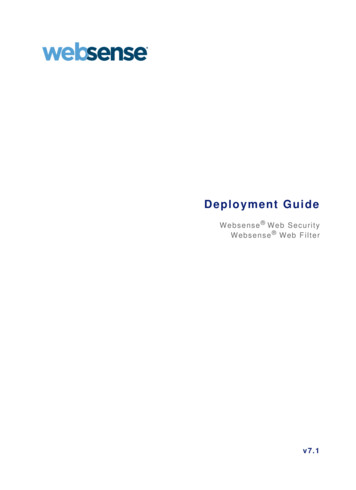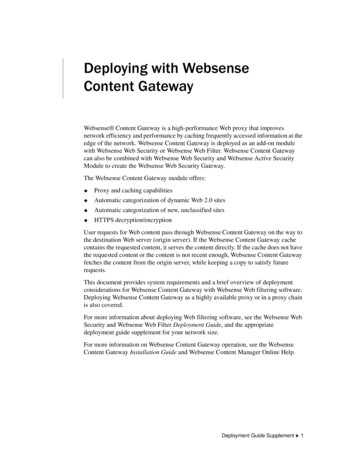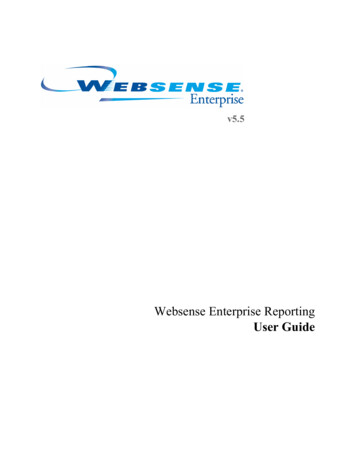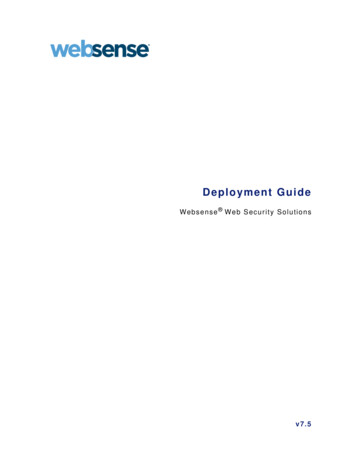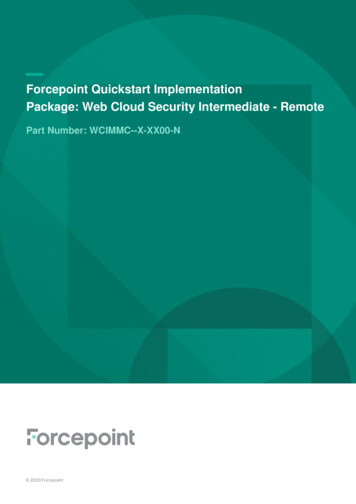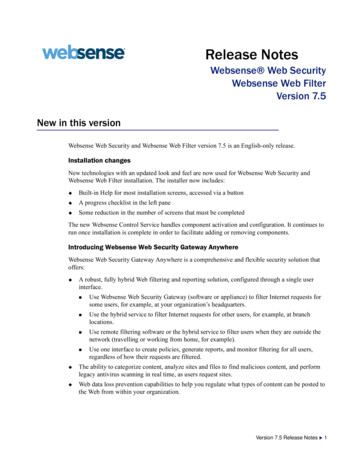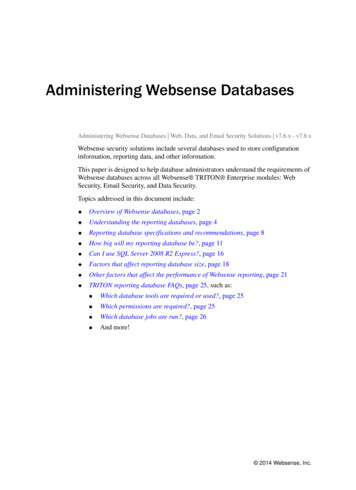
Transcription
Administering Websense DatabasesAdministering Websense Databases Web, Data, and Email Security Solutions v7.6.x - v7.8.xWebsense security solutions include several databases used to store configurationinformation, reporting data, and other information.This paper is designed to help database administrators understand the requirements ofWebsense databases across all Websense TRITON Enterprise modules: WebSecurity, Email Security, and Data Security.Topics addressed in this document include: Overview of Websense databases, page 2 Understanding the reporting databases, page 4 Reporting database specifications and recommendations, page 8 How big will my reporting database be?, page 11 Can I use SQL Server 2008 R2 Express?, page 16 Factors that affect reporting database size, page 18 Other factors that affect the performance of Websense reporting, page 21 TRITON reporting database FAQs, page 25, such as: Which database tools are required or used?, page 25 Which permissions are required?, page 25 Which database jobs are run?, page 26 And more! 2014 Websense, Inc.
Administering Websense DatabasesOverview of Websense databasesAdministering Websense Databases Web, Data, and Email Security Solutions v7.6.x - v7.8.xApplies to:In this topic Web Filter, Web Security, andWeb Security Gateway(Anywhere), v7.6.x - v7.8.x Data Security, v7.6.x - v7.8.x Email Security Gateway(Anywhere), v7.6.x - v7.8.x Websense Data SecurityFingerprint Database, page 3Websense TRITON solutions use a variety of databases for different purposes:configuration information, reporting data, URL categorization, fingerprinting, andforensics. Several data formats are used, including SQL, PostgreSQL, and Websenseproprietary formats.These databases include:DatabaseDescriptionWebsense reporting databasesWeb, Data, and Email SecuritySQL Server databases that store reporting and loggingdata for individual TRITON modules. The DataSecurity reporting database also stores configurationdata.See Understanding the reporting databases, page 4.Websense TRITON SettingsDatabaseWeb, Data, and Email SecurityPostgreSQL database that stores global configurationand infrastructure settings that affect all TRITONmodules. It is installed automatically on the TRITONmanagement server and requires no administratorconfiguration.Websense Master DatabaseWeb SecurityProprietary database that contains URL categories andprotocol definitions, as well as supporting information,such as risk class groupings.A copy of the Master Database resides on each FilteringService machine. By default, a full update is performeddaily. Incremental updates can occur much morefrequently if they are enabled on the Settings General Database Download page in Web Securitymanager.See “The Websense Master Database” in the v7.6, v7.7,or v7.8 Web Security Help for further details.2 Websense TRITON Enterprise
Administering Websense DatabasesDatabaseDescriptionWebsense RTM DatabaseWeb SecurityHolds and organizes filtering data for display in RealTime Monitor. This is an independent database (nothosted on SQL Server) installed with each RTM Clientand RTM Server instance.Administrators can specify when Real-Time Monitorcaptures data on the Settings Reporting Preferences page in Web Security manager. No otheraspect of database behavior is configurable.Websense Web SecurityForensics Databasev7.7 and later onlyWeb Security Gateway and Gateway AnywhereStores details about files that may be associated withadvanced malware threat activity in your network.Enable or disable the forensics repository, and configureits location and size on the Settings Reporting Dashboard page in Web Security manager.See “Configuring Dashboard reporting data” in the v7.7or v7.8 Web Security Help for details.Websense Data SecurityFingerprint DatabaseData SecurityStores Data Security fingerprints.See Websense Data Security Fingerprint Database,page 3.Websense Data SecurityForensics DatabaseData SecurityContains information about DLP and discoverytransactions that resulted in incidents, such as thecontents of an email body, including the From:, To:, andCc: fields, as well as actual attachments. Transactionscan also include Web posts, endpoint operations, anddiscovered as well as other events. For transactions thatoccurred on a Web channel, the forensics might includethe URL category property. For discovery transactions,forensics might include the host name and file name.Configure the size and location of the forensicsrepository in Data Security manager. Navigate to theSettings Deployment System Modules page andclick Forensics Repository under the managementserver.Websense Data Security Fingerprint DatabaseOne of the ways that you can classify data in Websense Data Security is by“fingerprinting” it. This lets Data Security detect sensitive information despitemanipulation, reformatting, or other modification. Fingerprints enable the protectionof whole or partial documents, antecedents, and derivative versions of the protectedinformation, as well as snippets of the protected information whether cut and pasted orretyped.Administering Websense Databases 3
Administering Websense DatabasesWhen you fingerprint data, the fingerprints are stored in the Data Security FingerprintDatabase on the TRITON management server and pushed to other Data Securitycomponents for fast analysis on those machines.To tune performance, you can configure the disk space and cache size of the databaseon the management server in Data Security manager. To do so:1. Log onto the TRITON console and select the Data Security module.2. Navigate to Settings Deployment System Modules.3. Select Primary Fingerprint Repository under the management server.4. Adjust the maximum disk space and cache size as needed.Secondary repositories are maintained by Websense Content Gateway and EmailSecurity Gateway. You can configure Data Security to detect fingerprints fromrepositories local to those machines (best practice) or from a remote machine, such asthe management server.Periodically, you must synchronize the fingerprints in the secondary repositories withthe ones on the management server. How often you synchronize depends on yourbusiness needs. For best performance, select a time with low traffic volume.To configure these settings:1. Navigate to Settings Deployment System Modules.2. Select Secondary Fingerprint Repository under the component or solution ofinterest.3. Choose the repository from which to detect fingerprints.4. Set the maximum cache size and synchronization frequency as needed.See “Configuring the fingerprint repository” in the v7.6, v7.7 or v7.8 Data SecurityHelp for instructions on configuring these settings.Understanding the reporting databasesAdministering Websense Databases Web, Data, and Email Security Solutions v7.6.x - v7.8.xApplies to:In this topic Web Filter, Web Security, andWeb Security Gateway(Anywhere), v7.6.x - v7.8.x SQL Server Express on theTRITON management server,page 7 Data Security, v7.6.x - v7.8.x Email Security Gateway(Anywhere), v7.6.x - v7.8.xSQL Server on another machine,page 7Each TRITON reporting database stores the logging data collected by a specificTRITON solution: Web Security, Data Security, or Email Security.4 Websense TRITON Enterprise
Administering Websense Databases Web Security Log Database stores Internet request data collected by Log Server,such as the source, destination, time, category, risk class, action (also calleddisposition), bytes sent and received, and so on for use by Web Security reportingtools.Log Server receives information about Internet activity from Filtering Service andinitially stores it locally:Whenever it is able, Log Server forwards the cache files to the Log Database,where the ETL job processes them into log records in a database partition:An end user who uses the Filtering Service has no direct or indirect influence overthe database. Thus, although the log entry is stored in the MSSQL database, theuser did not direct its storage and cannot retrieve it.The only interface to the database itself is from the Log Server, the Reportingservices, and the Manager. Filtering Service and Websense Content Gateway donot access the database, but instead send information via the Log Server. Email Security Log Database stores records of email traffic and the associatedfiltering actions on that traffic. Email Security reporting uses this information togenerate dashboard status charts and email activity reports showing, for example,the size and volume of messages processed, message filtering disposition, andemail source and destination.Administering Websense Databases 5
Administering Websense DatabasesLog and quarantine data are recorded as follows: Data Security Incident and Configuration Database stores information aboutemail, Web, and other traffic that resulted in data loss prevention (DLP) policybreaches, such as the source, destination, time, status, and severity of each breach.It also stores Data Security policy configuration and system settings.TRITON reporting databases are all hosted by Microsoft SQL Server. They may behosted by the same installation and instance, or by different installations or instances.Although Microsoft SQL 2008 R2 Express (SQL Server Express) is packaged withWebsense software, enterprises with high transaction volume should purchaseMicrosoft SQL Server Standard or Enterprise. (See Can I use SQL Server 2008 R2Express?, page 16 for guidance.)When you install Websense software, you can either install SQL Server Express onthe TRITON management server or connect to an existing SQL Server instance onanother machine.Related topics: Reporting database specifications and recommendations, page 8 How big will my reporting database be?, page 11 Can I use SQL Server 2008 R2 Express?, page 16 Factors that affect reporting database size, page 186 Websense TRITON Enterprise
Administering Websense Databases Other factors that affect the performance of Websense reporting, page 21 TRITON reporting database FAQs, page 25SQL Server Express on the TRITON management serverFor smaller deployments (up to 500 users), TRITON reporting databases can beinstalled on the TRITON management server.The TRITON Unified Security installer installs SQL Server 2008 R2 Express (32-bit)to host reporting databases when you select Install SQL Server Express on thismachine during installation. SQL Server 2008 R2 Express is the only version of SQLServer that may reside on the TRITON management server.If you are upgrading from a previous version of Web Security and have a differentversion of SQL Server installed on the TRITON management server machine, moveyour reporting database to a different machine for improved performance and a betteroverall product experience.SQL Server Express can run on the following Windows platforms. Note that WindowsServer 2008 R2 and later support all TRITON modules.WindowsServer 2003*Data Securityx (v7.6 only)Web Securityx (v7.6 only)WindowsServer 200832-bitxEmail SecurityWindowsServer 2008R2WindowsServer2012**xxxxxx* In v7.6.x, Windows 2003 is supported for a single TRITON module (Web Security orData Security), but not for a combination of modules. Windows Server 2003 is notsupported from v7.7 onwards.**Windows Server 2012 is supported for v7.8 and later.SQL Server on another machineIn medium and larger deployments (over 500 users), the best practice is to hostTRITON reporting databases on a Standard or Enterprise installation of MicrosoftSQL Server. SQL Server typically resides on a dedicated machine. It may hostdatabases for third-party applications, in addition to the Websense databases.When installing Websense software, you are prompted to provide the IP address orhostname of the SQL Server machine. You may also specify: An instance name (v7.7.x and later) The port to use for SQL Server communication (v7.7.x and later) Whether or not to encrypt communication with SQL ServerThe following databases are supported. Note that:Administering Websense Databases 7
Administering Websense Databases In versions 7.6 and 7.7, you cannot use SQL Server 2005 for the reportingdatabase if you plan to run Data Security or Email Security. Versions 7.8 and later do not support SQL Server 2005 for any module. Versions 7.7.x and earlier are not supported with SQL Server 2012.SQLServer2005 SP4*Data SecurityWeb SecurityxEmail SecuritySQLServer2008**SQLServer2008 R2ExpressSQLServer2008 R2***SQLServer2012‡xxxxxxxxxxxx*All editions except Web, Express, and Compact; all service packs; 32- and 64-bit, excludingIA64. Only supported for 7.6.x and 7.7.x.** All editions except Web, Express, and Compact; all service packs, 32- and 64-bit,excluding IA64.***All editions except Web and Compact; all service packs, 32- and 64-bit, excluding IA64.‡ Service Pack 1. Only supported for 7.8.x.Clustering is supported for all supported versions of SQL Server noted in the tableabove. See Can Websense reporting databases be hosted in a SQL Server cluster?,page 29.Reporting database specifications andrecommendationsAdministering Websense Databases Web, Data, and Email Security Solutions v7.6.x - v7.8.xApplies to: Web Filter, Web Security, andWeb Security Gateway(Anywhere), v7.6.x - v7.8.x Data Security, v7.6.x - v7.8.x Email Security Gateway(Anywhere), v7.6.x - v7.8.xIn this topic Hardware specifications, page 9 RAM, page 9 Disk considerations, page 9 Virtualization, page 10The performance of Websense reporting solutions is heavily dependent on the SQLServer, and the configuration of its underlying resources. The more you invest in thesystem, the better it will perform.For optimal results, host the reporting databases on Windows Server 2008 R2Enterprise Edition and SQL Server 2008 R2 Enterprise Edition.8 Websense TRITON Enterprise
Administering Websense DatabasesAlso consider the factors that follow when designing your database system.Hardware specificationsUse hardware that meets or exceeds Microsoft’s recommended (not minimum)hardware requirements for SQL Server.Microsoft SQL Server 143506(v sql.110).aspxMicrosoft SQL Server 2008 3506(v sql.105).aspxMicrosoft SQL Server 143506%28SQL.100%29.aspxMicrosoft SQL Server 2005 SP4 (Web Security v7.6.x or v7.7.x 3506%28v sql.90%29.aspxRAMThe reports that administrators generate often require that SQL Server be capable ofloading, summarizing, and processing large amounts of data across multiple physicaldatabases. Even if your organization doesn’t run complex reports, if there are multiplereporting administrators, the system may frequently be asked to generate severalreports concurrently. This places high demands on system memory. As a result,increasing RAM may provide noticeable performance improvements.Keep in mind that the operating system version and/or the version of SQL Server maylimit the amount of physical RAM that can be used by the system. For example,Windows Server 2008 Standard Edition supports SQL Server 2008 running with amaximum of 32 GB of RAM, no matter how much is available in hardware.Consult your operating system and SQL Server documentation to ensure that youutilize the maximum physical RAM possible in your chosen system.See Other factors that affect the performance of Websense reporting, page 21, forguidance on how the memory demands of Websense reporting may increase ordecrease based on how you use it.Disk considerationsBecause database operations are often I/O-intensive, a faster, dedicated disk canimprove how the database performs. Use high-performance disks whenever possibleto ensure optimum database operation.SQL Server performs better when there is minimal disk contention. For bestperformance, place tempdb files, reporting database files, and log files on separateAdministering Websense Databases 9
Administering Websense Databasesphysical drives with dedicated controllers. Follow SQL Server recommendations forinstalling and configuring SQL Server.RAID controllers provide disk redundancy and can increase disk throughput byspreading I/O activity across multiple physical disks. If you have a high-demandsystem, for peak performance, use a RAID 10 configuration managed by a hardwarebased RAID controller. (For systems with a lower I/O profile, RAID 5 may providesufficient performance at a lower cost.)For best performance: Use a hardware RAID controller, not software. Max out the RAID controller RAM cache. Use multi-channel links between the RAID controller and disk shelf or SAN. Separate the transaction logs and database files onto separate disks, arrays, orLUNs.This means separate spindles or RAID arrays, not just separate logical drives.If you are using a SAN, map the physical and logical LUNs to ensure you arereading and writing key components to separate physical drives. (This is to enablemultiple parallel IO operations.) Make sure that different database files are spread across different disks whereverpossible. For very large deployments, for example, plan to map wslogdb70 1 tospindle 1, wslogdb70 2 to spindle 2, and so on. The disk stripe size (how files are stored across striped arrays) is also critical andis a function of both the typical read/write size and the total database size. Contactto Microsoft or a sizing specialist for guidance. In large deployments, map different disks, arrays, or LUNs across differenthardware controllers to maximize parallel operations and controller cache usage. If you are using spinning disks, lower seek times are better.VirtualizationWebsense products can be deployed on virtualized systems. Be aware that the use ofvirtualization can affect system performance. Expect up to 25% performancedegradation.For specifics on virtualization support, see the article Virtual Machine Support,available from support.websense.com.Note that Microsoft has its own support guidelines for SQL Server, which can befound here:http://support.microsoft.com/?id 95689310 Websense TRITON Enterprise
Administering Websense DatabasesHow big will my reporting database be?Administering Websense Databases Web, Data, and Email Security Solutions v7.6.x - v7.8.xApplies to: In this topicWeb Filter, Web Security, andWeb Security Gateway(Anywhere), v7.6.x - v7.8.x Data Security, v7.6.x - v7.8.x Email Security Gateway(Anywhere), v7.6.x - v7.8.x Web Security size estimates, page11 Email Security size estimates,page 13 Data Security size estimates, page15When estimating the size of your TRITON reporting databases, keep the followingfactors in mind: Data Security logs only data violations, which typically represent a small fractionof your total Web and email volume. Email Security logs detected spam and quarantined email messages, whichtypically represent up to 90% of your email volume. Web Security logs all web transactions, which typically represent about 40% ofyour total web traffic volume when visits (the default) are recorded rather thanhits. See Web Security visits, consolidation, and full URL logging, page 18, fordetails. Beginning with 7.8.4, if IPv6 is used in the deployment, the Web Security LogDatabase may increase in size by approximately 4%WarningThese are averages calculated across a large number ofWebsense customers with widely varying deployments.While these numbers are useful for estimation, pleaseanalyze your system’s actual performance after a few daysor weeks to reassess your database sizing needs.Web Security size estimatesThe table below provides some general rules to help estimate the size of your WebSecurity Log Database, based on whether you are recording visits or hits. and URLhostnames or full URLs. By default, visits and URL hostnames are recorded.URL hostnamesFull URL loggingVisits3 MB per user per month4.5 MB per user per monthHits8 MB per user per month12 MB per use per monthAdministering Websense Databases 11
Administering Websense DatabasesThe size increase that accompanies full URL logging can vary widely based on thetype of URL being logged. For example, the following types of traffic tend to generatevery long URLs: Research database search and results URLs Search strings Social networking sites Online apps and gamesConsider the example of an organization with 7500 users who wants to store data for 3months, using monthly database partition rollover. Visits are enabled Full URL logging is enabled The Internet access policy is permissive A high percentage of Web traffic includes longer than average URLs (socialnetworking sites and online games)Based on this information, estimate 6 MB of data stored per user per month.Because rollover is monthly, it is necessary to allocate enough space to hold up to 4months of data. (This ensures that it is always possible to report on 3 months of data,even during the first days or weeks of the most recent month.)To start, therefore, 180 GB would be needed for the database logging partitions (notincluding the catalog database and AMT partition).6 MB * 7500 users * 4 months 180 GBIn addition, calculate space for the following: Database transaction logs, whose size depends on the recovery model youchoose. For full recovery (not recommended), allow for the same size as the data itself(180 GB in our example). For simple recovery, the log volume depends on the amount of databaseactivity. Allow roughly 30 percent of the size of an active database partition.In our example, the total size of 4 full partitions is 180 GB, so each partition is 45GB in size. So for simple recovery:0.3 * 45 GB 13.5 GBNote that this space is used only while data is being logged to the database.Inactive partitions, for example, have minimal transaction log activity. Likewise,during are time periods in which little or no Internet activity is being recorded, thetransaction log is very small. Temporary (tempdb) storage is used heavily during report generation and whenthe maintenance job is reindexing the database. The amount of tempdb spacerequired depends heavily on the types of reports being generated.In most environments, it is sufficient to allow twice the size of a partition:45 * 2 90 GB12 Websense TRITON Enterprise
Administering Websense Databases Temporary database (tempdb) transaction logs take up about 20 percent of thetempdb storage size. In our example:0.2 * 90 GB 18 GBThe total space required for the Web Security Log Database in our example, then, is:180 GB 13.5 GB 90 GB 18 GB 301.5 GBTipAs a best practice, record visits rather than hits to reducesignificantly the amount of storage space required.See Factors that affect reporting database size, page 18, for an explanation of theWebsense Web Security visits algorithm, other data reduction options, and the fullURL logging setting.Email Security size estimatesFor best practice in v7.7 and later, allow 1-3 MB per user per month when estimatingthe size of your Websense Email Security Log Database.For illustration, assume there will be 2 MB of data per user per month for 7500 users.Data will be kept for 3 months, with a scheduled monthly partition rollover.Because rollover is monthly, it is necessary to allocate enough space to hold up to 4months of data. (This ensures that it is always possible to report on 3 months of data,even during the first days or weeks of the most recent month.)This means that you would need 225 GB to start:2 MB * 7500 users * 4 months 60 GBIn addition, you need to calculate space for the following: The database transaction logs, whose size depends on the recovery model youchoose. For full recovery (not recommended), allow for the same size as the data itself(60 GB in our example). For simple recovery, the log volume depends on the amount of databaseactivity. Allow roughly 30 percent of the size of the available data.0.3 * 60 GB 18 GB Temporary database (tempdb) storage is used heavily during report generation.The amount of tempdb space required depends on the reports being run. As a bestpractice, allow the size of the logged data for temporary storage. In our example:60 GB Temporary database (tempdb) transaction logs take up about 20 percent of thetempdb storage size. In our example:0.2 * 60 GB 12 GBAdministering Websense Databases 13
Administering Websense DatabasesThe total space required in our example, then, is:60 GB 18 GB 60 GB 12 GB 150 GBUse the following tables to estimate storage space required for 30 days’ worth of databased on email volume. The same requirements for partitions, logs, and temporary databases apply. The estimates assume an average of 5 recipients per email message.With the Email Security Gateway Anywhere hybrid service enabled: Version 7.610 msg/user/day50 msg/user/day100 msg/user/day200 msg/user/day400 msg/user/day500 users200 MB1000 MB2000 MB4100 MB8300 MB1000 users400 MB2000 MB4100 MB8300 MB16700 MB2000 users800 MB4100 MB8300 MB16700 MB33500 MB5000 users2000 MB10500 MB20900 MB41900 MB83700 MB10 msg/user/day50 msg/user/day100 msg/user/day200 msg/user/day400 msg/user/day500 users600 MB3300 MB6600 MB13300 MB26700 MB1000 users1300 MB6600 MB13300 MB26700 MB53400 MB2000 users2600 MB13300 MB26700 MB53400 MB106800MB5000 users6600 MB33400 MB66800 MB133600MB267200MB10 msg/user/day50 msg/user/day100 msg/user/day200 msg/user/day400 msg/user/day500 users400 MB2300 MB4600 MB9200 MB18400 MB1000 users900 MB4600 MB9200 MB18400 MB36900 MB2000 users1800 MB9200 MB18400 MB36900 MB73800 MB5000 users4600 MB23100 MB46100 MB92200 MB184500 MB Version 7.7Without the hybrid service: Version 7.614 Websense TRITON Enterprise
Administering Websense Databases Version 7.710 msg/user/day50 msg/user/day100 msg/user/day200 msg/user/day400 msg/user/day500 users500 MB2600 MB5200 MB10400 MB20900 MB1000 users1000 MB5200 MB10400 MB20900 MB41800 MB2000 users2000 MB10400 MB20900 MB41800 MB83600 MB5000 users5200 MB26100 MB52200 MB104500MB209000MBFor version 7.6, the calculations used are: With the hybrid service:(0.01436 0.0055* RECIPIENT)* SPEED * USER Without the hybrid service:(0.03023 0.0124* RECIPIENT)* SPEED * USERFor version 7.7, the calculations used are: With the hybrid service:(0.01622 0.02348* RECIPIENT)* SPEED * USER Without the hybrid service:(0.0384 0.01322* RECIPIENT)* SPEED * USERIn both sets of calculations: USER represents the total number of users. RECIPIENT is the average number of recipients for each message. SPEED is the average message volume for each user per day.Note that the Email Security Gateway hybrid service drops or blocks the followingtypes of email before they reach on-premises components: Email that comes from known bad (blacklisted) sources Email that has a very high spam score in the cloudThis significantly reduces the amount of data stored in the Email Security LogDatabase, as shown in the examples above.Data Security size estimatesThe Websense Data Security Incident and Configuration Database is different fromthe Web and Email Security Log Databases in that it stores both configuration and logAdministering Websense Databases 15
Administering Websense Databasesdata. In addition, it logs only policy violations, not all events. In order to estimate thepotential size of the Incident and Configuration Database, consider the following:FeatureImpact on Database SizeDiscovery incidents(not standard with WebsenseTRITON Enterprise)14 KB per incidentTypically, no more than 3.5 GB totalNetwork and endpoint incidents10 KB per incidentTypically, 30 KB per user per monthUser directory import data8 KB per recordTypically, no more than 1 GB totalConfiguration data200 MBAs a general guideline, it is unlikely that your Data Security Incident andConfiguration Database will require more than 9 GB of storage total, no matter howmany users are in your environment.The volume of configuration and incident data varies based on your use of DataSecurity features as explained in Factors that affect reporting database size, page 18.Can I use SQL Server 2008 R2 Express?Administering Websense Databases Web, Data, and Email Security Solutions v7.6.x - v7.8.xApplies to: Web Filter, Web Security, and Web Security Gateway (Anywhere), v7.6.x 7.8.x Data Security, v7.6.x - v7.8.x Email Security Gateway (Anywhere), v7.6.x - v7.8.xMicrosoft SQL Server 2008 R2 Express is bundled into the Websense TRITONUnified Installer.Regardless of the resources available on the machine hosting the database engine,Microsoft limits the resources that SQL Server 2008 R2 Express can use to: 1 GB of RAM 1 physical CPU 10 GB of data per databaseThis results in practical limits on the amount of data that can be stored in SQL Server2008 R2 Express, while still maintaining acceptable performance when generatingreports and processing log data. For best performance, no more than 30 GB of data16 Websense TRITON Enterprise
Administering Websense Databasesshould be stored in SQL Server 2008 R2 Express across all Websense modules. Thesizing recommendations below are based on this assumption.For an explanation of particular demands that Websense reporting places on availablememory, see Other factors that affect the performance of Websense reporting, page21.Use the charts below to see how much data you can store using SQL Server Expressbased on the Websense module or modules you are using. You can then determine ifthat limit still meets your data retention requirements. If so, you can use SQL Server2008 R2 Express.NoteStandalone Data Security installations can support up to5000 users with SQL Server 2008 R2 Express.UsersWeb*Web and DataData andEmail**Web, Data, andEmail2000 Do not useDo not useDo not useDo not use200045 days30 daysDo not useDo not use150060 days45 daysDo not useDo not use100090 days60 daysDo not useDo not use7504 months3 monthsDo not useDo not use5006 months4 months30 daysDo not use2501 year8 months60 days30 days1001 year 1 year5 months3 months* Web Securit
Websense security solutions include several databases used to store configuration information, reporting data, and other information. This paper is designed to help database ad ministrators understand the requirements of Websense databases across all Websense TRITON Enterprise modules: Web Security, Email Security, and Data Security.
